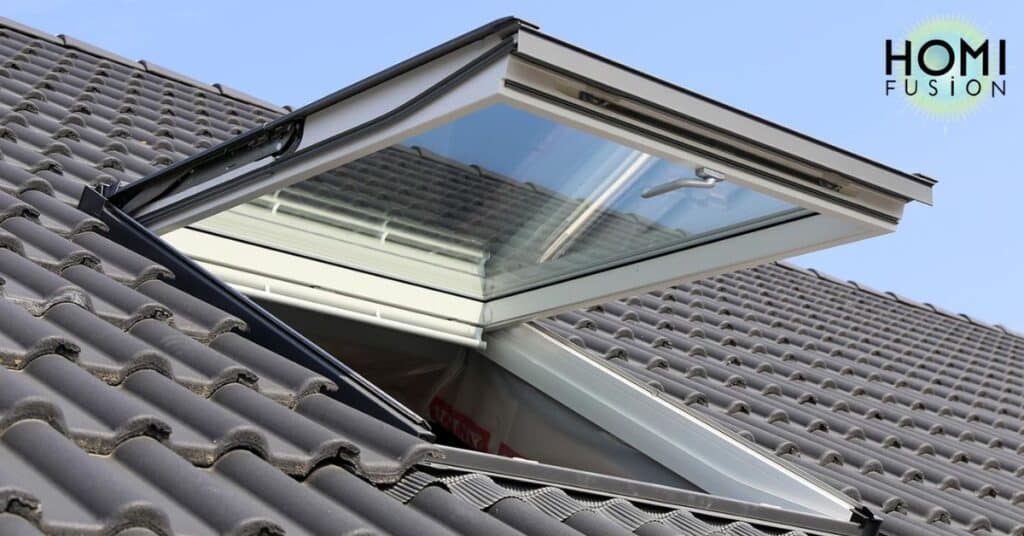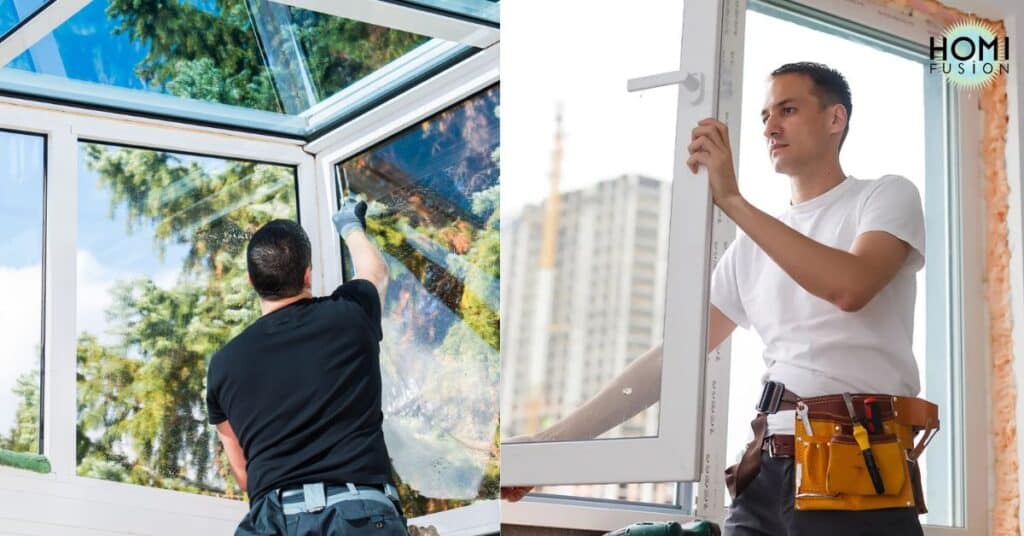A window is a transparent opening in a wall or door that allows light and air to enter and provides a view to the outside.
Unlocking a window from the outside is a straightforward process. Identify the latch or lock and utilize an extended object such as a robust stick or a dedicated tool to access and manipulate it. Apply a slight force and the window will smoothly open providing a refreshing breeze from the outdoors.
To open a window from outside first locates the latch or lock. Then use a long object like a stick or a specialized tool to reach and manipulate it. Apply gentle pressure to swing the window open and enjoy the fresh air.
Removing Window Screens
It is a simple task that enhances cleaning and maintenance. Begin by locating the screen tabs or clips usually found on the window frame. Gently press or lift these tabs releasing the screen and making it easy to take off and clean.
Once the tabs are disengaged carefully lift the screen from its track. Clean the screen using a mild solution and rinse it with water before letting it air dry. Reinstall the screen by aligning it with the window frame and securing it back in place with the tabs or clips.
Avoiding Window Damage
This is a simple task that enhances ventilation and facilitates cleaning. Start by locating the screen tabs or clips on the window frame. Gently push pull or release these tabs to loosen the screen. Once freed carefully lift the screen out of its track taking care not to damage the frame or the mesh.
If your window has multiple screens or different types ensure you keep track of each one for easy reinstallation. Clean the screens by rinsing them with water or using a mild soapy solution and let them air dry before placing them back in the window frame. Regularly removing and cleaning window screens contributes to a healthier indoor environment and maintains the clarity of your views.
Unlocking Slide Windows
These are a straightforward process that allows for easy opening and closing. Begin by locating the window lock usually positioned along the track or on the window frame. Slide the lock mechanism to the unlocked position by pushing or pulling it in the designated direction.

Once unlocked gently slide the window horizontally along its track to open it fully or partially depending on your preference. Take care to move the window smoothly to avoid any jams or damage to the frame. With the window open enjoy improved airflow and ventilation throughout the space. Remember to relock the window when not in use to maintain security and prevent unwanted entry.
Also read this:https://homifusion.com/three-window-curtain-ideas/
Assessing Window Types
Evaluating window types considers functionality and style. Choose between single or double-hung for ventilation control and explore options like casement sliding or bay windows for varying aesthetics and features.
Single-Hung Windows
Single-hung windows have a fixed upper sash and a movable lower sash. They are cost-effective and common in various architectural styles. However they provide limited ventilation as only the bottom sash can be opened.
Double-Hung Windows
Unlike single-hung windows, both sashes of double-hung windows are movable. This design allows for better ventilation control as both the upper and lower sashes can be opened. They are versatile and suitable for various settings.
Casement Windows
Casement windows open outward on hinges providing unobstructed views and excellent ventilation. They are energy-efficient when properly sealed but their design may limit their use in specific architectural styles.
Sliding Windows
Sliding windows feature horizontal sashes that move back and forth along a track. They are easy to operate cost-effective and provide good ventilation. However their design may limit the size of the opening.
Bay and Bow Windows
Bay and bow windows protrude outward from the building creating a unique architectural feature. They consist of multiple panels that can be fixed or operable. While they offer panoramic views and additional interior space, they can be more expensive and complex to install.
Jiggle a Sliding Window to Loosen the Lock
If you find a sliding window lock stuck tries jiggling the window gently to loosen it. Start by locating the lock along the window track or frame. Then apply slight controlled movements while attempting to release the lock allowing you to open the sliding window smoothly.
Be cautious not to use excessive force as this may damage the lock or the window mechanism. If jiggling does not work consider using a lubricant on the lock or consulting the manufacturer guidelines for specific recommendations on troubleshooting and maintenance.
Opening a Sash Window From the Outside
Opening a sash window from the outside is feasible with a few simple steps. First locate the window latch or lock on the exterior frame. If it is within reach release the latch by pushing or pulling it to the unlocked position. If the window is higher consider using a long tool like a sturdy stick or a specially designed window-opening tool to manipulate the latch.

Once the latch is undone gently push or pull the sash upward or downward depending on the window type to open it. Take care not to apply too much force and ensure the window moves smoothly within its tracks. This method allows you to enjoy fresh air and ventilation without needing access from the inside.
Also read this:https://homifusion.com/top-10-fiberglass-window/
Safety Precautions
Implement window opening limits and use safety devices to prevent falls while also maintaining windows regularly utilizing guards and educating household members for overall safety.
Window Opening Height Limits
- Set limits on how wide windows can be opened, especially for upper floors, to prevent accidental falls.
- Use window restrictors or locks to control the maximum opening distance and enhance child safety.
Regular Maintenance Checks
- Inspect window frames locks and latches periodically for any signs of wear or damage.
- Promptly repair or replace faulty components to ensure windows function properly and securely.
Window Guards or Grilles
- Install window guards or grilles particularly in homes with young children to prevent falls and enhance overall safety.
- Ensure these safety features meet relevant standards and do not impede emergency exit routes.
Emergency Egress Planning
- Familiarize household members with window emergency escape routes especially in bedrooms and other living spaces.
- Ensure that windows designated for emergency egress are easily accessible and operational.
Childproofing Measures
- Keep furniture or other climbable items away from windows to discourage children from attempting to reach them.
- Educate children about window safety emphasizing the importance of not leaning or playing near open windows.
Necessary Tools
Having the right tools makes any task more efficient. For basic household repairs a versatile toolkit should include essential items like a screwdriver set pliers and an adjustable wrench. Additionally keep a tape measure a utility knife and a flashlight handy for various tasks around the home.
For more specialized projects consider tools like a power drill a hammer and a level. These tools can be invaluable for tasks such as hanging pictures assembling furniture or tackling DIY home improvement projects. Having a well-equipped toolbox ensures you are prepared for common household tasks and empowers you to handle unexpected repairs with ease.
Legal Considerations
It plays a crucial role in various aspects of life. When entering into agreements it is essential to read and understand contracts thoroughly before signing to ensure compliance with legal terms. Additionally understanding local laws and regulations is crucial in activities like renting a property or starting a business helping you avoid potential legal issues.
In personal matters such as creating a will or managing estate planning seeking legal advice ensures your wishes are legally binding and protects your assets. Staying informed about legal responsibilities and rights contributes to making well-informed decisions and navigating life is complexities with confidence and compliance.
Use a Knife to Unlatch a Sash Window
When faced with a stuck sash window using a knife can be a handy solution. Start by locating the window latch or lock on the interior frame. Gently slide the knife between the sash and the frame aiming to reach and manipulate the latch. Applying slight pressure wiggle the knife until the latch releases allowing you to open the sash window with ease.

Exercise caution to avoid damaging the window or injuring yourself and be sure to only use this method on windows you have permission to open. If the window remains stuck consider seeking professional assistance or exploring alternative methods to avoid causing any harm to the window mechanism.
Push the Sash of a Sash Window Up
Opening a sash window is often as simple as pushing the bottom sash upward. Start by unlocking the window latch or lock located on the interior frame. With the latch released use both hands to push the bottom sash upward along its tracks. Apply even pressure to ensure a smooth and controlled movement allowing you to adjust the window’s height and enjoy improved ventilation.
Remember to be gentle while pushing the sash to avoid any damage to the window frame or mechanism. If the window is still difficult to move, consider checking for any obstructions in the tracks or seek assistance from a professional if needed.
Opening a Casement Window From the Outside
Opening a casement window from the outside requires locating the window is handle or crank mechanism. Identify the specific type of locking system in place and use the corresponding tool or handle to unlock it. Be cautious with the force applied to avoid damage to the hinges or the window frame.
If the window has multiple locking points ensure all are released before attempting to open the window fully. Casement windows provide excellent ventilation and unobstructed views when opened making them a popular choice. Regular maintenance such as lubricating hinges and cleaning tracks can contribute to smoother operation and longevity.
Prize or Push Open an Unlatched Casement Window
When dealing with an unlatched casement window gently prize it open with your hands. Start by locating the window handle or crank mechanism on the interior. If the window is stuck use a flat tool like a putty knife or a similar object to carefully wedge between the frame and the sash. Apply slight pressure while moving the tool along the edge to release any friction allowing you to gently push the window open.
Exercise caution to avoid damaging the window or injuring yourself. If the casement window remains stubborn check for any debris or obstructions in the tracks and address them before attempting to open it further. Seeking professional help may be advisable if difficulties persist.
Lever the Casement Off the Frame
It locates the hinges or attachment points on the interior. Using a flat tool likes a putty knife or screwdrivers gently insert it between the window sash and the frame. Apply even pressure to lever the casement away from the frame gradually releasing it from the hinges.
Exercise caution during this process to avoid damaging the window or injuring yourself. If the casement does not easily come off ensure all locking mechanisms are disengaged and check for any additional screws or fasteners that may be securing it to the frame. Seeking professional assistance may be necessary if difficulties persist or if you are unsure about the process.
Opening Skylight Windows
It can bring fresh air and natural light into your living space. Start by locating the window controls which may include a crank or a motorized system. Use the provided handle or control panel to open the skylight allowing for improved ventilation and an open-air atmosphere.

When operating skylight windows, be mindful of safety measures. Ensure that the windows are securely locked when closed and never leave them unattended when open to prevent accidents or water leakage during inclement weather. Regularly clean and maintain the skylight mechanisms to ensure smooth operation and to enjoy the benefits of a well-ventilated and naturally lit space.
Dealing With Jammed Windows
Handling jammed windows requires a systematic approach to ensure a safe and effective solution. Begin by identifying the cause of the jam which could be due to paint debris or a misaligned frame. Use a putty knife or a flat tool to gently loosen any paint or material that may be sticking the window sash to the frame.
If the window remains stuck check for debris in the tracks and clear it away. In cases of misalignment gently lift or push the window into place ensuring it sits properly within the frame. Be cautious not to force the window as this may cause damage. Regular maintenance such as cleaning tracks and lubricating hinges can help prevent future jams and ensure smooth window operation. If difficulties persist consider seeking professional assistance to address any underlying issues.
Overcoming Window Stoppers
Overcoming window stoppers involves a careful inspection of the frame to identify and clear any debris or misalignments. Using a flat tool such as a putty knife, gently remove obstructions and ensure smooth movement.
Regular maintenance including track cleaning and lubrication contributes to preventing future stoppages and ensures hassle-free window operation. If challenges persist seeking professional assistance may be necessary for a comprehensive solution.
Cut or Break the Window Glass in an Emergency
In emergencies breaking or cutting window glass may be necessary for a swift escape. If the window is equipped with safety glass locate the corners where it is weaker and use a sturdy object like a hammer or a heavy tool to strike with force. Aim for the corners to increase the chances of breaking the glass more easily.

Alternatively, if you have access to a glass-breaking tool like an emergency hammer with a pointed tip use it to strike the glass near its edges. Apply force in a controlled manner to create an opening for escape. Always exercise caution to minimize the risk of injury and choose a method suitable for the type of glass in the window. In emergencies prioritizing personal safety and quick evacuation is paramount.
How to Break Window Glass
Breaking window glass can be necessary in emergencies. If the window is not equipped with safety glass such as tempered or laminated glass uses a pointed object like a hammer rock or heavy tool to strike the glass near its edges. Aim for the corners or edges where the glass is weakest to increase the chances of breaking it effectively.
Alternatively, if the window is made of tempered glass apply pressure to the center of the glass with a sharp object such as a center punch or a pointed tool. Once a small hole is created continue applying pressure to expand the hole and shatter the glass. Always prioritize safety and be cautious of flying glass shards. Breaking window glass should only be done in emergencies and with the utmost care.
Frequently Asked Question
How do you slide open a window from the outside?
Use a long tool like a stick or a window-opening tool to reach and manipulate the latch then slide the window open.
How does a sliding window open?
A sliding window opens by horizontally moving its sashes along a track.
What holds a window open?
A window is held open by its latch lock or a device like a window stay or friction hinge.
Are window locks secure?
Window locks can be secure if properly installed and of high quality.
Conclusion
Understanding and implementing effective safety measures for windows are essential in promoting a secure living environment. Whether it is unlocking different window types addressing jammed or stuck windows or dealing with emergency situations a combination of proper tools regular maintenance and cautious approaches contributes to overall safety. It is crucial to prioritize child safety consider legal implications and be aware of emergency exit routes.
The versatility of window type demands tailored approaches such as using a knife to unlatch a sash window or leveraging tools to address specific issues. Ultimately a well-informed and proactive approach to window safety ensures not only the comfort and convenience of daily living but also the protection and well-being of occupants. Regular checks thoughtful precautions and timely maintenance together create an environment where windows serve their purpose effectively while minimizing potential hazards.







